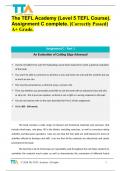Exam (elaborations)
FMT3701 Assignment 2 2024
- Course
- Foundation Phase Mathematics
- Institution
- University Of South Africa
The inclusion of practice questions and exercises enhances the document's utility, allowing students to reinforce their knowledge and test their comprehension.
[Show more]





